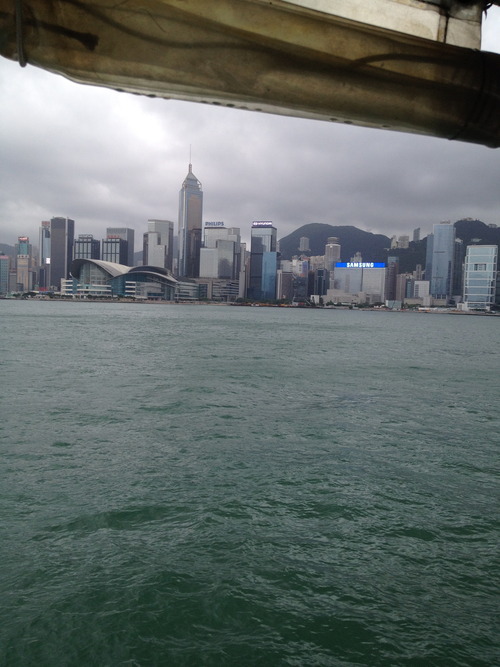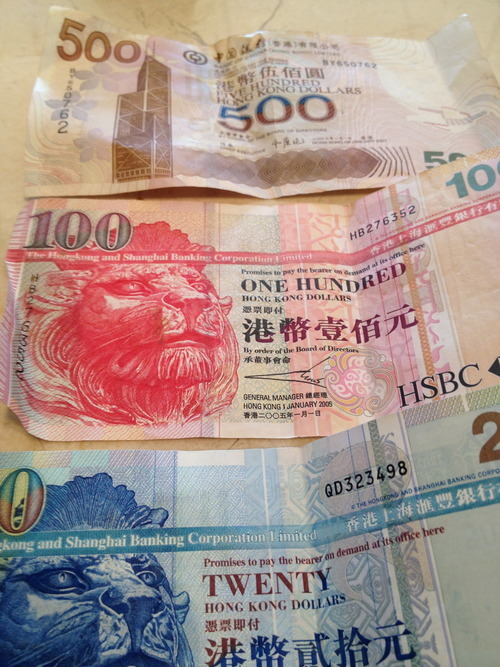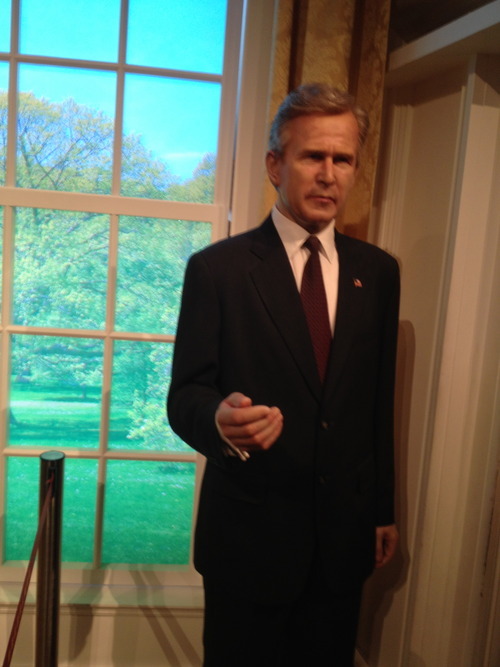Hong Kong Files #3
Today I decide to meet up with Kevin and take the ferry across Victoria Harbor to Central Hong Kong, the business district spurting with skyscrapers.
On the way I’m accosted by more Indians and Burmese attempting to sell me purses, suits, and drugs, but by this point, I barely acknowledge them – to make eye contact requires a more persistent NO!
“Please sir, would you like to try a suit?”
“No, sorry.” I glance up to see it’s the same Burmese man who led me to his shop yesterday. “I already am having a suit made. With you in fact. "
He recognizes me, a second later he looks embarrassed. “Oh, so sorry sir. I will see you later, yes?”
I nod, and move on. The two Burmese men beside him redouble their efforts to get my attention. If I bought one suit from their friend, maybe I want another? No, sorry. Moving on, it’s 9:30 AM, and I’m already sweating.
It looks like a 4 star hotel with valet and small men in red coats dashing back and forth to help customers. It’s nicer than my hotel, filled with Europeans sipping drinks, like something from an earlier century.
Holiday Inn? Really? Makes you wonder what the YMCA is like. (I’ll pass by it later, it’s one of the best hotels in the city.)
I meet up with Kevin and we walk down to the pier. For about 50 cents you can climb aboard a ferry which leaves every ten minutes. Using my Octopus pass, I scan it across the turnstile and I see 3.8 Hong Kong dollars are automatically deducted.
We climb on board and are greeted to an amazing view of the city, our boat circled by birds as we traverse choppy blue water. The ride is over quickly, maybe five minutes. Kevin wants to go to a hat shop and I’m just happy to tag along.
Darting across lanes of traffic, we weave through a series of mini malls, and more shopping. There is no end to the sheer variety of stores here; and in Kowloon, the three most popular appearing to be skin cream stores like the Body Shop, jewelry stores all with Rolex signs, and a never ending parade of 7-11’s.
I’ve never seen more 7-11’s per square mile; every convenience store appears to be a 7-11 and they are on every block.
I walked into one to check out prices and noticed that a tiny bag of M&M’s, barely more than a mouthful, was selling for about $1.10. Just like back home! Didn’t buy the M&M’s.
We begin to hike up hill. Central is quiet, reserved, it’s Sunday and most of the businesses are empty. It’s not a place people live so much as a place for them to do business.
For the first time, I’m no longer surrounded by people, my new companions are the buildings, skyscrapers built on every available inch of land.
I point out that the skyscrapers look strange to me, and Kevin informs me that I think they look strange because they are unusually thin, built as high as possible on as little land as possible because space is at such a premium.
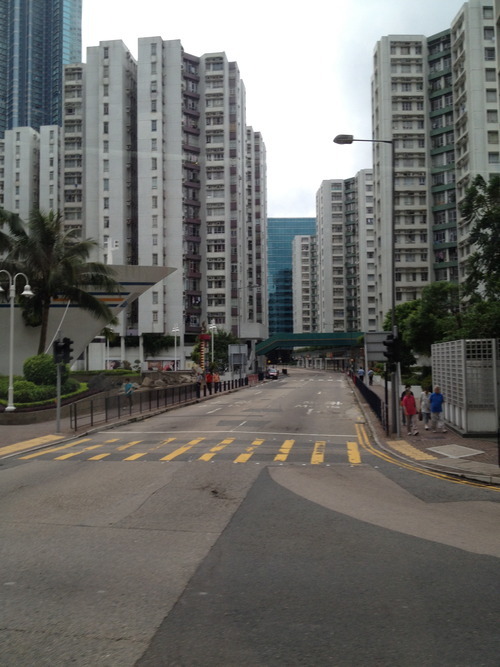 We stop at a 7-11 and Kevin gets a beer. A group of men sit about outside, drinking. Kevin tells me this is a Hong Kong tradition.
We stop at a 7-11 and Kevin gets a beer. A group of men sit about outside, drinking. Kevin tells me this is a Hong Kong tradition.People typically just gather round outside 7-11’s to drink.
They all appear to be working class people, smoking cigarettes; none of them speak much, too busy nursing their beers.
Further up into the city, we stop by a boutique hat shop. Kevin wants to try on hats, none of which fit his small head. There are a lot of fedora’s with bows, Newsie caps, and American sports team ball caps, including one for the Chicago Cubs.
Yes, even here, I can buy American sports paraphernalia but the jokes on the Chinese – only they could possible think wearing a Cubs' hat would be cool.
We walk through the botanical gardens, a free zoo with simians kept behind sturdy black cages. Mostly monkeys and other tiny orange haired critters, but one little fellow looks Chinese with whiskers that resemble a Fu Manchu moustache. I try to take some photos but the distance and the bars prevent it
We cross into Hong Kong park, which is filled with Filipino women enjoying their day off as they share food and chat. Most of them are maids; they are to Hong Kong what many Mexicans are to the United States, low-end labor the city imports to do the jobs Hong Kongers don’t want to do.
There appears to be some sort of beauty contest going on, and I note the lack of men. I ask Kevin why there aren’t that many Filipino men in Hong Kong, but he doesn’t know.
That’s when I take note of something else. There are no homeless people in Hong Kong. Three days now, and I haven’t spotted one in a city of 7 million.
Where are they? Does the city sweep them up and push them into China, or offer them some sort of job and place to live, or do the locals simply look out for each other? I don’t know, but it’s the first time I’ve been in a city and not ever seen a homeless person.
We pass by a wedding couple standing on a street corner having photos taken, the bride in a beautiful white dress, her husband in a black tux. Western style weddings have surpassed more traditional style Chinese weddings, and having unique wedding photos are an important status symbol among upper middle class Chinese couples.
I’ve read that Chinese will often rent out parts of a beach, or an entire building just to get that special photo. If I hadn’t read that, I would have the thought the bride and groom were just models; but something about the way he nuzzles her tells me otherwise.
We take the subway back to Kowloon. Using the Octopus pass, I wave it like a wand and the money is magically deducted from the card. No need for exact fare, the pass takes care of everything. The subways are clean and efficient. Hong Kong may have the best public transportation in the world.
We hit a local Chinese restaurant, and I order the Sweet and Sour pork which tastes just like something I could order back home. I’m just happy to see that many of the Chinese dishes I love aren’t like Tex Mex and are authentically enjoyed by the Chinese. Kevin and I agree to meet for dinner tomorrow and I head home.
Later I’ll go back to the tailor for a second fitting. This time it’s a Cantonese man who measures me. The clothes are half finished; the coat only has one sleeve, the pants no pockets, buttons or zipper.
I put them on and he takes new measurements, asking if I want my sleeves or pants shortened, or my coat further taken in. It takes about ten minutes, and I agree to come back tomorrow to pick up the finished product.
I head back to the Night Market and pass by the Jockey Club. About fifty men stare silently at teleprompters flashing numbers, silently praying their horse will win.
They have no interest in watching the race, or any race, as every big screen TV in the room flashes endless arrays of numbers. The gamblers here are only interested in covering their bets. The greed is palatable, for these men a way of life.
I stop by a foot massage parlor, filled with locals busy getting their feet massaged.
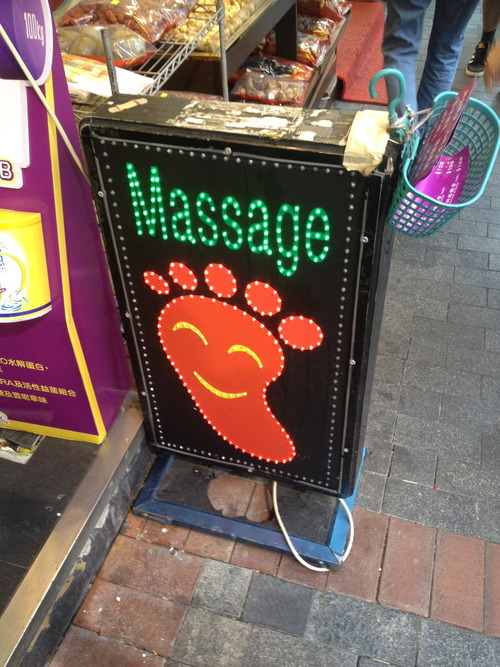 When I don’t know where to go in a foreign city, I have one simple rule: do what the locals do. Like all foot massage parlors in Hong Kong, a glowing neon sign with a raised foot stands outside, a happy face smiling from its sole.
When I don’t know where to go in a foreign city, I have one simple rule: do what the locals do. Like all foot massage parlors in Hong Kong, a glowing neon sign with a raised foot stands outside, a happy face smiling from its sole.I walk in and sink into a chair. A heavy woman with an iron grip boils my feet in a tub of water, then goes to work on my calves, shins, and ankles before working her way to the bottom of my feet.
It’s heavenly, and only about $15 American. Not cheap by Filipino prices, but that’s reasonable by LA prices.
The TV is turned to a local channel. I watch a cooking show and although I can’t understand what is being said, I can follow the images. This episode the chef is showing the audience how to make lobster flavored ice cream, which judging by her facial expression is supposed to be delicious.
The next show is titled in English and Cantonese: Battle of the Senses. The premise is simple; two teams attempt to be the first to discover answers by being deprived a “sense.”
For example, one of the team members might have to sing through a mike underwater while his teammates attempt to figure out what he is singing. Another game involves blindfolding the entire team and then giving them something to touch, which they then have to identify what it is.
This episode takes place at the Chinese version of Universal Studios and is essentially an advertisement for the theme park.
The teams are blindfolded as three “famous” characters are brought out for them to touch and figure out who they are: Woody Woodpecker, Frankenstein, and the Gingerbread Man. Both teams figure out who all three are in under two minutes.
I have to say I’m impressed, I’m not sure my students would get Woody Woodpecker. Then again they might not get Frankenstein or the Gingerbread Man either.
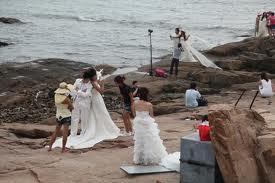 Back at my hotel there is a huge wedding taking place in the ballroom. I sneak a peek inside and see a drunk bride surrounded by a half dozen of her friends, all drinking from glasses of wine.
Back at my hotel there is a huge wedding taking place in the ballroom. I sneak a peek inside and see a drunk bride surrounded by a half dozen of her friends, all drinking from glasses of wine. The people are all Cantonese; but outside of their language and facial features, it could be an American wedding, down to the one lone rebel girl who has refused to dress up by wearing jeans with a spiked belt and a Led Zeppelin T-Shirt.
There’s some sort of story there, but I’m not about to crash a Chinese wedding.
Hong Kong Files #4 Victoria’s Peak
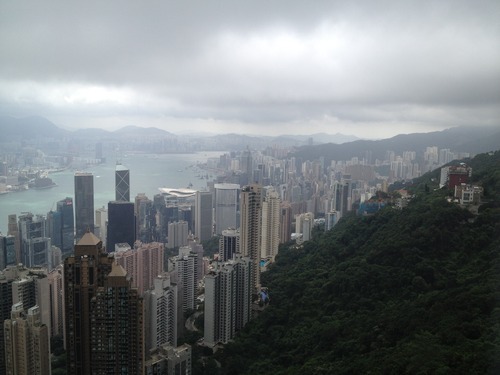 Today it’s off to Victoria’s Peak, or the “Peak,” the highest point in Hong Kong.
Today it’s off to Victoria’s Peak, or the “Peak,” the highest point in Hong Kong. By the 1880s, Hong Kong was getting overcrowded, but the British colonials were hemmed in by the mountains; and short of being transported by “coolies,” had no way to traverse them – at least until the cable car was invented.
Suddenly, the entire mountain was traversable; using a pulley system, steam pumps and steel cables, it was possible to move up the mountain quickly and efficiently.
To this day the mountains surrounding Victoria’s Peak are some of the most highly priced real estate in the world. The average home here goes for about $260 million dollars (post bubble), and rent is upwards of $200,000 a month. (That’s American dollars, not Hong Kong dollars.)
Big corporations have bought up the land and now use it for corporate retreats. The real estate is Hong Kong’s secret weapon and one of the methods by which the city generates revenue.
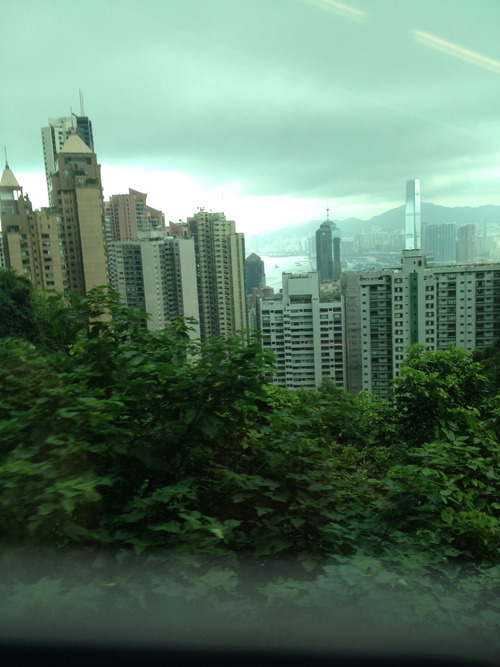
The peak's tram is a red cable car with forward facing seats. For about $2, I wave my Octopus pass and take a seat by the window.
As the pulley goes to work, I can feel gravity pushing against my back; it’s like being on a roller coaster before it plunges down the other side.
If the cable breaks, the entire car would abruptly reverse course and scream down the hill – I calculate odds of survival from slim to nil.
At the top is a shopping mall and terrace that offers one an amazing view of the city. The air is cooler up here; there is a pleasant breeze, and for the first time in days I feel like I can really enjoy being outside.
There’s even a McDonalds! (The Chinese call them McCafe’s.) And yes, there is also a 7-11, and a New York Fries, and a Hard Rock Café. Once again, America wins!
The view is dizzying. I can look out into the harbor where huge barges resemble toy boats as the bay turns into a magnificent river that divides the city in half.
If the Grand Canyon is the most amazing natural phenomenon I’ve observed, then Hong Kong is the most amazing city view I’ve seen. Most people mistakenly believe that humans can’t improve upon nature, that they only take away from natural beauty; but I don’t believe that is the case with Hong Kong.
The buildings accentuate the land's uniqueness; even the forests on the mountain were built by design – the trees and topsoil were planted 130 years ago by appraising developers. There’s a reason why the land up here is expensive. The view is unique.
Back inside I pay about $20 to take a tour of Madame Tussaud’s wax museum.
Outside a group of Indonesian women take photos with a wax doll of Pierce Brosnan dressed as James Bond.
There is also a wax doll of Michelle Yeoh, a Hong Kong actress from an earlier Bond film with Brosnan, but that’s not who people are interested in – they want to take photos with Bond, James Bond. Chinese, Europeans, South East Asians – Bond is Bond.
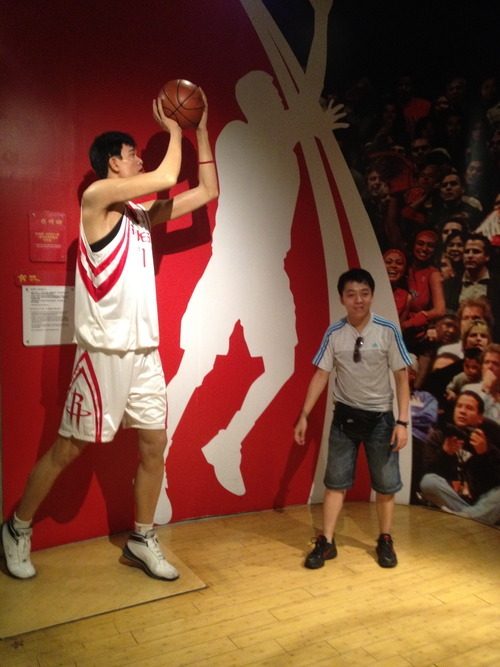 Inside are a variety of figures and a handful of Hong Kong movie celebrities, including Jackie Chan and Jet Li.
Inside are a variety of figures and a handful of Hong Kong movie celebrities, including Jackie Chan and Jet Li. There is also a wax figure of Chairman Mao and Yao Ming; a normal Chinese man stands next to Yao Ming’s statue and looks like a hobbit.
For the most part, however, it’s American and British celebrities. Crowds flock to take their photo with Johnny Depp, Brad Pitt, Angelina Jolie, Madonna, Lady Gaga, Elvis, The Beatles, Einstein, Shakespeare, Spider-Man, Michael Jackson and Her Majesty, the Queen of England.
There are even several dictators present: Saddam Hussein and Adolf Hitler and statues of Obama and George Bush.
A special photographer is set up to let people take photos with Obama in his oval office. I don’t see anyone opt for a photo with George Bush.
Taking the trolley back down, I notice now why all the seats face upward in one direction. If anyone was to sit facing downward, gravity would pull them out of their seat and send them tumbling down onto the floor.
I decide to hike through Hong Kong Central and spend the rest of the day walking up and down Hong Kong’s streets.
Central is where the foreigners gather, in bars with leather seats, serving burgers and pints of Guinness, offering mueslix and yogurt. British and Australians mostly, but I also overhear a number of American accents, including American sounding Asians.
A crowd of people surround a tea vendor, offering up 7 Hong Kong dollars for a plastic cup of sweetened tea. I buy one; it’s good.
I find myself on Hollywood Boulevard (the irony of this is not lost on me) and begin peeking in antique shops. Jade figurines, ivory combs, metal lanterns, exquisite model ships, dragon masks, dusty cabinets and chairs; is it authentic? No idea, but it looks old.
I stop by the Ho Man temple, a small Buddha shrine where people pray to the twin gods of martial skill and education. Dark, red walls, incense curled into lamp shades that slowly burn above, small boxes with mysterious Chinese characters embedded into the wall, statues of serene Chinese with legs folded, palms praying.
Unlike Christian churches, there is nothing awe inspiring about it; the point of the temple is to allow people to pray, not to frighten them into submission.
A handful of people come in and light incense. Crouching onto their knees, they pray, bowing, incense held to their forehead before rising to place the incense into sandy canisters. I don’t take any photos and I’m ignored.
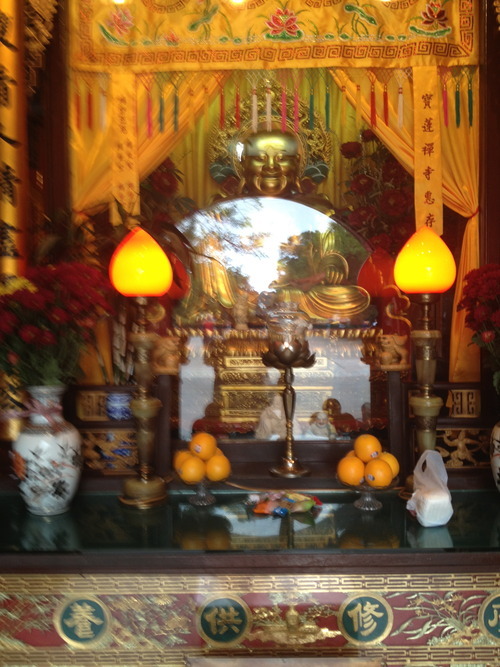 Being Buddhists, I doubt they care what I do one-way or the other so long as I’m quiet and respectful.
Being Buddhists, I doubt they care what I do one-way or the other so long as I’m quiet and respectful. A second room has more statues of serene looking Chinese, but this one has offerings of fruit placed before them: one bowl with a pineapple, another with bananas, a third with grapes, a fourth with dragon fruit.
I have no idea what it means, but my guidebook states that people come here to pray when they need help with exams.
I walk back up the hill to the Sun Yat Sen museum, a colonial mansion near the top of Hong Kong island hill. Who is Sun Yat Sen you ask?
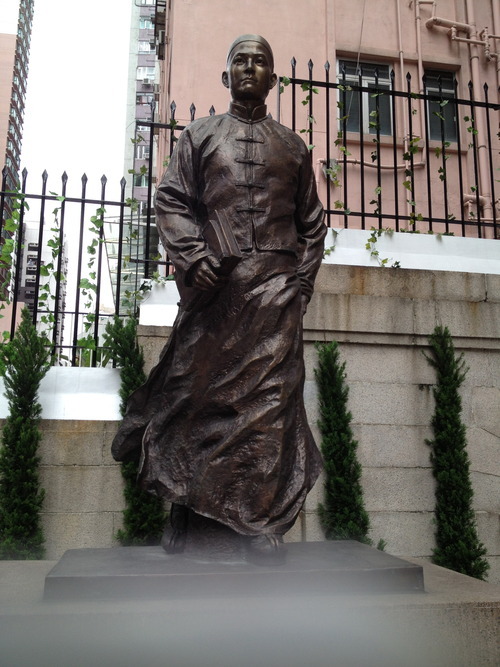 Well he’s important, important enough to appear in the 7th edition of the McGraw Hill 10th grade world history textbook. If you can make it into a “standardized” world history text book, consider yourself a historical VIP, an icon that will be remembered for generations. The museum’s practially empty.
Well he’s important, important enough to appear in the 7th edition of the McGraw Hill 10th grade world history textbook. If you can make it into a “standardized” world history text book, consider yourself a historical VIP, an icon that will be remembered for generations. The museum’s practially empty.Sun Yat Sen was an impoverished cobbler’s son who became educated, converted to Christianity, and later a revolutionary in an attempt to modernize China. Hong Kong is where he agitated against the evils of the Chinese government until he was eventually banished and forced to flee to London.
Traveling around the world, he raised money for the Chinese revolution, but eventually realized that money alone wouldn’t be enough to force change.
Befriending the Japanese, Sun Yat Sen later attempted to use the Japanese military in an attempt to overthrow the Chinsese government, but ultimately failed. In his later years, when he realized the Japanese were using him in an attempt to both destabilize and conquer China, he turned to help offered by the Soviets, inadvertently starting China on the path to Communism. Sun Yat Sen’s writing’s would have a great deal of influence on a young Mao Zedong.
As Marx is to Lenin, Sun Yat Sen is to Mao Zedong.
It’s also not all that interactive or interesting, but there are a number of photographs with captions in both English and Chinese. I’m more interested to see that Sun Yat Sen ditched his first wife (an arranged marriage) in favor of a much hotter second wife about ten years before he died.
In his coat and tie he looks like an early 20th century Edwardian businessman. In spite of all his failure, Sun Yat Sen was a prophet. He knew that if China was ever to unify and become great again, it would have to adopt a more Western world view.
But even I think he would be shocked by how Western the Chinese have become. Later today I will spot:
A movie poster for Abraham Lincoln, Vampire Hunter. (In Chinese characters.)
A Chinese marching band practicing with Scottish bag pipes.
A liquor store in Kowloon (meaning mostly Chinese customers) selling a wide array of foreign spirits. (including Chivas!)
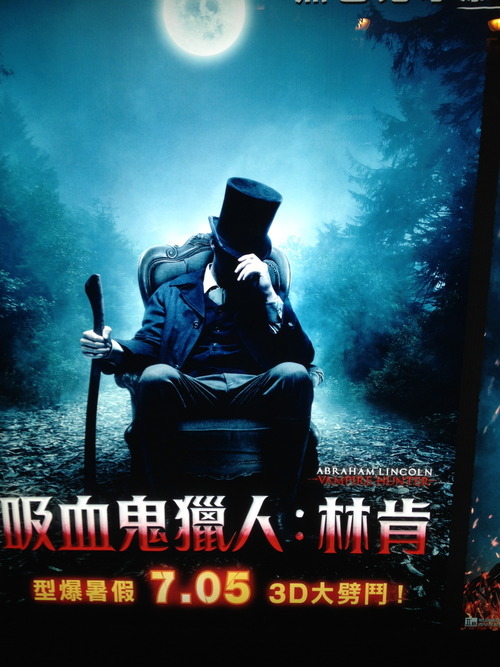
At the end of the day I will pick up my coat and three pairs of tailormade pants: they fit like a glove. Total cost: $330.
I ask the tailor, a native to Hong Kong, why the Chinese don’t have more of their own brands. The Japanese have Sony, Toyota, Honda, Seiko; the Koreans have Hyundai, Kia, Samsung – the Chinese have nothing.
The tailor nods his head. “So far, we only make for others. It take long time to build brand. No trust. Louis Vuitton; it be around for long time. People trust. But China needs to build trust, very difficult to compete against foreigner and big money.”
“How long until they do create brands?” I ask. The tailor thinks about this for a long time. Finally he says, “Hard to say. Thirty more years, maybe?”
We sit and drink a Chinese beer.
Copyright 2012 Brian Leiken
LA Teacher
http://leiken.blogspot.com/
Brian Leiken is an LA inner-city, Special Ed teacher and author of three books for and about his students available on lulu.com. He's also penned I Went Into Teaching for the Money about his first year of teaching in LA. And best of all, he's my son:)
Crossed Out, Messed Up and Knocked Down by Brian Leiken at http://www.lulu.com/
laleiken.tumblr.com
